Blog Archives
First Day of Summer Garden Update
It’s the first day of summer, and it feels like it! Like many of you, there are good and bad things happening in the garden due to the excessive rain and milder temperatures. Honestly…we kind of need this heat to push along some of our warm season plants.
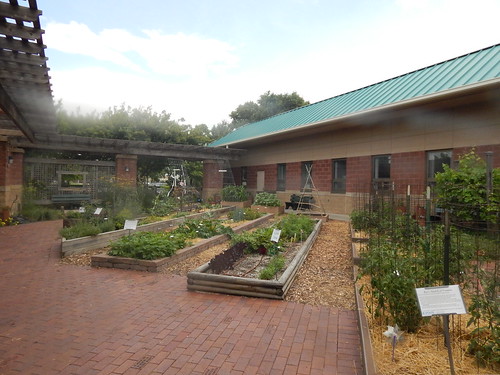 It has been awhile since an update, but that doesn’t mean we have been MIA in that garden. As you can see, despite the weather challenges, the garden is planted, we have been harvesting, and things are going well. One benefit of the raised beds (and the drainage tiles underneath our garden!) is that no matter how much rain we have gotten, it drains away fairly quickly. So we are not seeing too much root damage from saturated soils.
It has been awhile since an update, but that doesn’t mean we have been MIA in that garden. As you can see, despite the weather challenges, the garden is planted, we have been harvesting, and things are going well. One benefit of the raised beds (and the drainage tiles underneath our garden!) is that no matter how much rain we have gotten, it drains away fairly quickly. So we are not seeing too much root damage from saturated soils.
The herbs & pollinators garden has been growing gangbusters, with absolutely huge bronze fennel, lush parsley, and several beautiful agastaches.
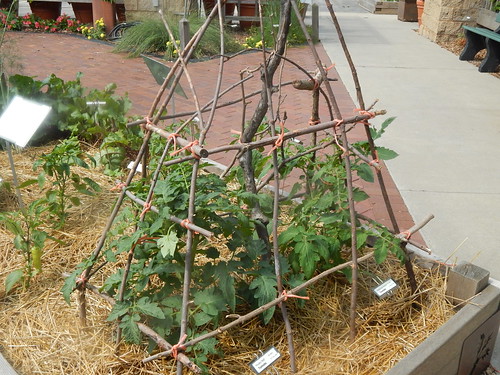 We once again have a SNAP-Ed garden, where we are highlighting the ability to use SNAP dollars to purchase garden plants. We track our expenses and the value of harvested crops. We also have to budget for every purchase, so there is often not money to purchase tomato cages or similar items. The gardeners built this homemade tomato cage for the two tomato plants. We will see if it fares better than last year’s homemade cage!
We once again have a SNAP-Ed garden, where we are highlighting the ability to use SNAP dollars to purchase garden plants. We track our expenses and the value of harvested crops. We also have to budget for every purchase, so there is often not money to purchase tomato cages or similar items. The gardeners built this homemade tomato cage for the two tomato plants. We will see if it fares better than last year’s homemade cage!
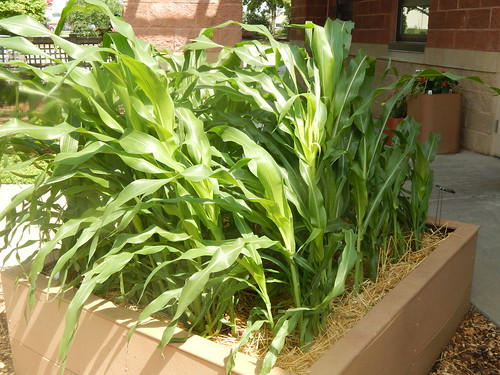 Corn is something new for us in the Demo Garden, simple because of the space requirements. We tried a Peruvian corn variety a couple years ago, but it didn’t grow. This corn is ‘Glass Gem’ popcorn. We are interested to see how it performs in the small area we have given it.
Corn is something new for us in the Demo Garden, simple because of the space requirements. We tried a Peruvian corn variety a couple years ago, but it didn’t grow. This corn is ‘Glass Gem’ popcorn. We are interested to see how it performs in the small area we have given it.
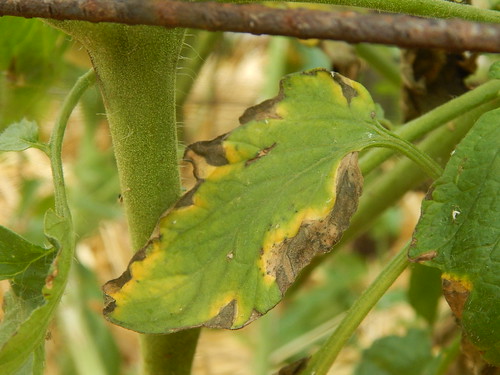 Lest you think all is well in the garden, we are starting to see a fair amount of early blight on the lower tomato leaves. We hadn’t mulched the garden until last week, which probably didn’t help prevent disease. Mostly this is a rain and humidity problem. Cultural controls would include mulching, caging or staking, and keeping the leaves dry. Fungicide options would include chlorothalonil and copper-based products. It is important to note that fungicides only prevent new leaves from becoming infected, NOT cure infected leaves.
Lest you think all is well in the garden, we are starting to see a fair amount of early blight on the lower tomato leaves. We hadn’t mulched the garden until last week, which probably didn’t help prevent disease. Mostly this is a rain and humidity problem. Cultural controls would include mulching, caging or staking, and keeping the leaves dry. Fungicide options would include chlorothalonil and copper-based products. It is important to note that fungicides only prevent new leaves from becoming infected, NOT cure infected leaves.
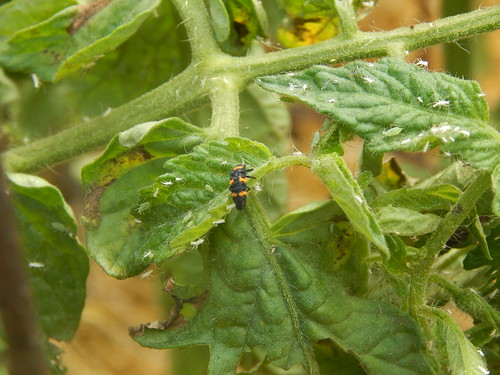 The other thing that we are seeing right now are aphids all over the tomatoes. This is quite abnormal, but probably due to the cooler weather. The benefit of hotter weather is that it should help the tomatoes grow faster and slow down the aphids (which normally like cooler weather). The white specks are the molted husks of the aphids. The black and orange guy is a ladybug larvae that is happily feeding on the aphids. We are hoping that between the hotter weather and the ladybugs, we won’t need to treat for the aphids.
The other thing that we are seeing right now are aphids all over the tomatoes. This is quite abnormal, but probably due to the cooler weather. The benefit of hotter weather is that it should help the tomatoes grow faster and slow down the aphids (which normally like cooler weather). The white specks are the molted husks of the aphids. The black and orange guy is a ladybug larvae that is happily feeding on the aphids. We are hoping that between the hotter weather and the ladybugs, we won’t need to treat for the aphids.
There is much more to see in our garden, so come on over at visit us sometime!
Tomato Update
Our tomatoes are generally looking great this year! After 2 years of tomato heartache and heartbreak (heat one year, herbicide injury and heat the next), we finally have some great looking tomatoes again. We’re starting to see a touch of Early Blight here and there, and there’s also a little bit of residual herbicide damage that is just now showing up. Most of the plants have fruit set and are growing like weeds! We haven’t fertilized at all, other than a little bit of a liquid starter fertilizer at planting and working in some compost this spring.
 The ‘Taxi’ tomato plant (orange fruit) is the early leader as far as fruit set. I’m withholding judgement until they ripen without excessive cracking, however.
The ‘Taxi’ tomato plant (orange fruit) is the early leader as far as fruit set. I’m withholding judgement until they ripen without excessive cracking, however.
 I’ll be honest that I’m excited about this funky tomato. This is one of two fruit that I’ve seen set on the ‘Limmony’ plant. It is an heirloom that can get up to 1 pound in weight! There will probably only be a few fruit from this plant anyway.
I’ll be honest that I’m excited about this funky tomato. This is one of two fruit that I’ve seen set on the ‘Limmony’ plant. It is an heirloom that can get up to 1 pound in weight! There will probably only be a few fruit from this plant anyway.
 This is the ‘Arkansas Traveler’ tomato, and I’m a little confused so far by the shape of the green tomatoes. It is supposed to be a pink, round tomato at maturity, but the fruit are giving the impression of being a little more oblong. The number of fruit set so far is great for an heirloom.
This is the ‘Arkansas Traveler’ tomato, and I’m a little confused so far by the shape of the green tomatoes. It is supposed to be a pink, round tomato at maturity, but the fruit are giving the impression of being a little more oblong. The number of fruit set so far is great for an heirloom.
 This is our Chocolate Cherry plant in the Pizza Garden. It has some suspicious looking brown lesions on the stems and some brown, wilting leaves. I rather suspect it looks like Bacterial Canker, which is largely a seedborne disease. I knew I should have kept using the old batch of seeds, rather than buying new ones. A boiling water treatment before planting would also have helped. I’m still waiting for a confirmation on the diagnosis, but there’s a high probability that this plant is going to be removed. Sadness!
This is our Chocolate Cherry plant in the Pizza Garden. It has some suspicious looking brown lesions on the stems and some brown, wilting leaves. I rather suspect it looks like Bacterial Canker, which is largely a seedborne disease. I knew I should have kept using the old batch of seeds, rather than buying new ones. A boiling water treatment before planting would also have helped. I’m still waiting for a confirmation on the diagnosis, but there’s a high probability that this plant is going to be removed. Sadness!
That’s just a quick overview of a few of our tomatoes this year. I’ll keep you posted on the poor Chocolate Cherry plant.
Troubles in Vine-Land
As I mentioned in passing on Tuesday, we have several different things going on with our vining vegetables – cucumbers, squash, etc. Actually, the melon plants are all still in good shape, so the problems are restricted to the cucumbers and various squashes.
Here’s the first one:
 The cucumbers in the Family of 4 Garden are coated with these…any ideas? I’ve seen numerous samples of vine plants come in this month with the same signs and symptoms. I think what tricks folks is all of the white flecks. This is actually a severe aphid infestation. If you look closely, especially in the upper left corner of the picture, you can see the green buggers. In the middle of this picture is an ant…and ants like to “farm” aphids and protect them from predators so the ants can feed on the sticky honeydew that the aphids excrete as they feed. The white flecks? Those are the aphid “skins” as they grow and mature they “molt” and leave those white skins behind. I’m sure there’s a technical term, but I can’t remember off the top of my head.
The cucumbers in the Family of 4 Garden are coated with these…any ideas? I’ve seen numerous samples of vine plants come in this month with the same signs and symptoms. I think what tricks folks is all of the white flecks. This is actually a severe aphid infestation. If you look closely, especially in the upper left corner of the picture, you can see the green buggers. In the middle of this picture is an ant…and ants like to “farm” aphids and protect them from predators so the ants can feed on the sticky honeydew that the aphids excrete as they feed. The white flecks? Those are the aphid “skins” as they grow and mature they “molt” and leave those white skins behind. I’m sure there’s a technical term, but I can’t remember off the top of my head.
 To make matters worse, the cucumbers also have these terrible looking insects on them! Can it get any worse? Well, actually, you might recognize the one as a ladybug, and the black and orange lizard-like bug…that’s the larvae of the ladybug! These are the good guys that are enjoying quite a feast of aphids!
To make matters worse, the cucumbers also have these terrible looking insects on them! Can it get any worse? Well, actually, you might recognize the one as a ladybug, and the black and orange lizard-like bug…that’s the larvae of the ladybug! These are the good guys that are enjoying quite a feast of aphids!
So, what are we doing about the aphids on the cucumbers? Well, honestly, the answer is nothing. We’ve gotten quite a bounty of cucumbers, and the plants are still doing pretty well overall. The ladybugs aren’t controlling the aphids at this point, although given a couple of weeks they might get there. Spraying would kill the ladybugs and may not do much to prolong the life of the cucumber vines. We’ll probably let them go and pull the plants out in a few weeks if they become completely unproductive.
 On to the next problem… An observant Master Gardeners saw this on the underside of one of the squash leaves on Tuesday. Theses are squash bug eggs. I’ve gotten several questions about why we aren’t having problems with squash bugs in the garden this year. The answer has pretty much been that we’ve been lucky. The renovated garden may have helped that situation too. At this point, we aren’t going to bother spraying, since most of the squash will be leaving the garden soon due to the third problem we’re seeing…
On to the next problem… An observant Master Gardeners saw this on the underside of one of the squash leaves on Tuesday. Theses are squash bug eggs. I’ve gotten several questions about why we aren’t having problems with squash bugs in the garden this year. The answer has pretty much been that we’ve been lucky. The renovated garden may have helped that situation too. At this point, we aren’t going to bother spraying, since most of the squash will be leaving the garden soon due to the third problem we’re seeing…
 Ugh…powdery mildew. This is a disease that we often see on zinnias and other common garden plants about this time of year. Usually you start out seeing round, powdery white spots on the leaves. It seems like most of our squash went from 0 to 60 in almost no time flat, because the leaves are pretty well coated on several different varieties of squash. There are treatment options, but they are most effective as preventatives or very early in the infection period. These plants just aren’t worth saving at this point. Besides, we’re tired of zucchini! There are powdery mildew resistant varieties, but they can still get the disease in a bad year.
Ugh…powdery mildew. This is a disease that we often see on zinnias and other common garden plants about this time of year. Usually you start out seeing round, powdery white spots on the leaves. It seems like most of our squash went from 0 to 60 in almost no time flat, because the leaves are pretty well coated on several different varieties of squash. There are treatment options, but they are most effective as preventatives or very early in the infection period. These plants just aren’t worth saving at this point. Besides, we’re tired of zucchini! There are powdery mildew resistant varieties, but they can still get the disease in a bad year.
As you can see, a lot of things are starting to go downhill fast in the garden this year. Luckily we’ve got some seeds started inside and garlic on order for later this fall!
Another Look at the Grafted and Non-Grafted Heirloom Tomatoes
On getting back to work this week, some of the differences between the grafted and non-grafted heirlooms have become increasingly apparent.
 This is the view of the non-grafted part of the bed. The two plants on the end aren’t bad, but the next 4 grafted plants in line have withered to almost nothing. In fact, we did yank them out after I took this picture. They obviously weren’t going to produce anything, so it was time to go!
This is the view of the non-grafted part of the bed. The two plants on the end aren’t bad, but the next 4 grafted plants in line have withered to almost nothing. In fact, we did yank them out after I took this picture. They obviously weren’t going to produce anything, so it was time to go!
 Looking the other direction, the grafted heirlooms are just a bit too healthy. (The brown, crispy plant on the right side is one of the non-grafted plants.) Of course, the healthy plants don’t seem to have many tomatoes either that I could see. But they at least have the potential to produce tomatoes! That’s a step in the right direction.
Looking the other direction, the grafted heirlooms are just a bit too healthy. (The brown, crispy plant on the right side is one of the non-grafted plants.) Of course, the healthy plants don’t seem to have many tomatoes either that I could see. But they at least have the potential to produce tomatoes! That’s a step in the right direction.
I rather suspect that there are some tomatoes on the grafted plants, but it’s hard to see them in that jungle. (I just justified that suspicion by going out and finding a ripe Marmande hidden in the jumble of leaves.)
Friday PhotoEssay
Yet another Friday is here, and it is also the last Friday for Lunch in the Garden this summer. We’re featuring peppers, and we’ve definitely got a good crop of peppers in the garden!
 These gorgeous bell peppers are from the ‘Big Bertha’ plants. The bell peppers seem to go in flushes, but this week was obviously a heavy harvest.
These gorgeous bell peppers are from the ‘Big Bertha’ plants. The bell peppers seem to go in flushes, but this week was obviously a heavy harvest.
 Look! The tomato plant laid a golden egg! Okay…this year, that might almost be true. The yellow “egg” is a Golden Rave Roma tomato and the red pepper behind it is actually a purple ‘Merlot’ pepper. Yes, really. We left it on the plant long enough, it turned red! Pretty neat!
Look! The tomato plant laid a golden egg! Okay…this year, that might almost be true. The yellow “egg” is a Golden Rave Roma tomato and the red pepper behind it is actually a purple ‘Merlot’ pepper. Yes, really. We left it on the plant long enough, it turned red! Pretty neat!
 Something decided that this melon was ready to eat, even if we didn’t! I think it is getting close, but I’m waiting for those dark green sutures (the stripes) to fade to something a little more creamy. It’s probably edible right now (well, obviously), but wouldn’t be very tasty. The melon are taking a lot longer to ripen than I expected them to – maybe a combination of how heavily they are set and the lovely weather.
Something decided that this melon was ready to eat, even if we didn’t! I think it is getting close, but I’m waiting for those dark green sutures (the stripes) to fade to something a little more creamy. It’s probably edible right now (well, obviously), but wouldn’t be very tasty. The melon are taking a lot longer to ripen than I expected them to – maybe a combination of how heavily they are set and the lovely weather.
 We picked this ‘Black Krim’ tomato on Tuesday when it just had a tinge of pink. Good thing, because the rain the other night might have caused it to crack.
We picked this ‘Black Krim’ tomato on Tuesday when it just had a tinge of pink. Good thing, because the rain the other night might have caused it to crack.
 Here’s that same tomato this morning. It’s almost ready to eat. My past experience with the Black Krim is that it should be a more purple/brown color when ripe, but either the heat is causing the colors to be bleached out or the seeds we got were a little more genetically varied toward pink instead of purple. These tomatoes remind me a lot of the ‘Rose’ heirloom tomatoes we grew last year, at least in color. (Haven’t eaten one yet, so not sure about flavor.)
Here’s that same tomato this morning. It’s almost ready to eat. My past experience with the Black Krim is that it should be a more purple/brown color when ripe, but either the heat is causing the colors to be bleached out or the seeds we got were a little more genetically varied toward pink instead of purple. These tomatoes remind me a lot of the ‘Rose’ heirloom tomatoes we grew last year, at least in color. (Haven’t eaten one yet, so not sure about flavor.)
 One of my coworkers brought this cool tomato in last week. Aren’t those designs artistic and cool? Anyway, this is an extremely characteristic example of Tomato Spotted Wilt Virus. The tomatoes are still fine to eat, they just look bizarre. Usually the plants are infected while still in the greenhouse, and the only thing to do is to pull the plants out when you see a problem.
One of my coworkers brought this cool tomato in last week. Aren’t those designs artistic and cool? Anyway, this is an extremely characteristic example of Tomato Spotted Wilt Virus. The tomatoes are still fine to eat, they just look bizarre. Usually the plants are infected while still in the greenhouse, and the only thing to do is to pull the plants out when you see a problem.
Have a great weekend! Posting will be light for the next couple of weeks, but don’t forget to check back occasionally!




